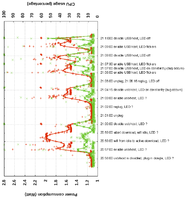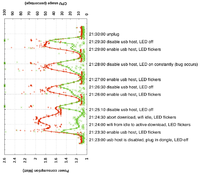porg
Active Member
porg filed bug #317 on 2013-05-01:
Now I answer here, because the bug tracker still has no ability to attach files to it:
And I did 2 test runs and monitored with sysinfo, and my assumption was proven right!

 openpandora--usb-host-on-off--logs+plots.zip
openpandora--usb-host-on-off--logs+plots.zip
Note: To read that graph chronologically, you must read from bottom to top.
Could not do it better, sysinfo does yet not support timed comments, I had to do that manually.
Graph interpretation: The baseline for the power consumption in state "unplugged" and "USB host disabled" is the same! Except if the bug occurs (LED on although USB host disabled). In that case, the consumtion is higher.
neelix replied on 2013-05-02 0030:On my Pandora, due to bad internal WiFi, I use an Edimax EW-7811Un USB WiFi adapter, which has a status-LED, flickering according to the network activity.
After disabling USB-host through the settings menu, the WiFi functionality is gone, but the device's LED is still on. So some current must still flow into the USB device.
The LED now has a permanent light, no flickering! This lack of "device intelligence" indicates that the device was indeed turned off, just current flowing directly to the LED circuit unaltered).
I can repeat the aforementioned steps many times, the behavior is the same.
As soon as I then first physically unplug and reinsert the device, the LED remains off eventually.
From then on, every further issuing of "Disable USB-host" through the settings menu turns the device LED completely off.
Smells like a kernel bug to me! As it requires one real un/re-plugging, from then on works ok.
That's a hardware issue. The wifi dongle will start drawing current as soon as you plug it in, regardless of whether the kernel module is enabled. The reason the LED remains off when you first plug it in is because it is only lit once initialised by the dongle's firmware, which doesn't happen until the OS interacts with it.
Now I answer here, because the bug tracker still has no ability to attach files to it:
Thanks for the explanation, on how a USB device firmware works.Neelix: The reason the LED remains off when you first plug it in is because it is only lit once initialised by the dongle's firmware, which doesn't happen until the OS interacts with it.
Really??? I always left my USB WiFi adapter plugged, and assumed the USB port is completely shut down if USB host is disabled and that the device only starts consuming power if USB host gets enabled, the port getting powered only then.Neelix: The wifi dongle will start drawing current as soon as you plug it in, regardless of whether the kernel module is enabled.
And I did 2 test runs and monitored with sysinfo, and my assumption was proven right!

 openpandora--usb-host-on-off--logs+plots.zip
openpandora--usb-host-on-off--logs+plots.zipNote: To read that graph chronologically, you must read from bottom to top.
Could not do it better, sysinfo does yet not support timed comments, I had to do that manually.
Graph interpretation: The baseline for the power consumption in state "unplugged" and "USB host disabled" is the same! Except if the bug occurs (LED on although USB host disabled). In that case, the consumtion is higher.
Attachments
Last edited by a moderator:

